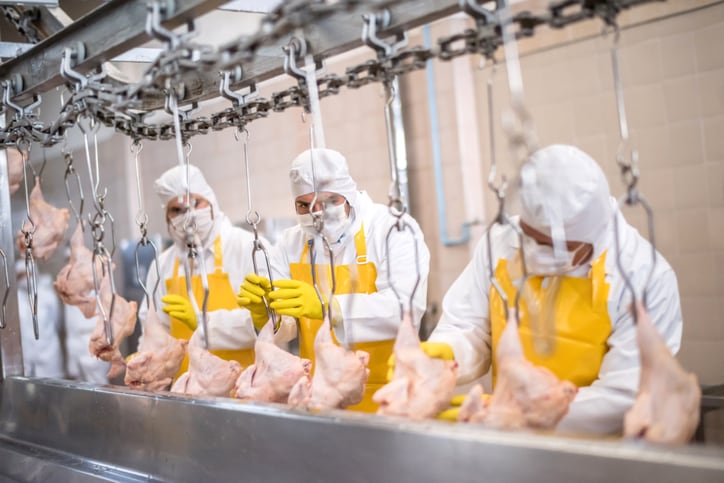During the company’s second quarter earnings call yesterday, Tyson CEO Donnie King acknowledged that beef, pork, chicken and prepared food volumes “are not where we expect [them] to be by now” as labor and supply chain challenges slowed production in the first half of the year compared to the same period last year.
Overall, volume fell 0.7% to 14 billion pounds in first half of fiscal 2022 compared to 14.08 billion, with prepared foods taking the biggest hit with a 4% drop to 1.68 billion pounds, followed by a 2.9% drop in beef to 3.58 billion pounds and a 2.3% drop in pork to 2.6 billion pounds.
Only chicken inched up 2.1% to 6.24 billion pounds, helping it to outpace market through operating improvements.
Despite this setback, King said he remains confident that Tyson will improve its performance in the back half of the year “as new team member recruitment strategies support an improved labor position and higher throughput.”
With labor tight across industries, many manufacturers, including Tyson are struggling to fill vacancies and attribute the need for higher wages as a key component of rising inflation that is driving up product price.
Legal and citizenship support for staff
But King argues there is more to successfully recruiting and retaining talent beyond wages, although they are important, such as supporting employees’ life goals.
For example, Tyson announced last month that it will invest more than $1m in non-profit groups to expand legal and citizenship support for its US team members who hail from 160 countries and aspire to become American citizens.
It also expanded its Upward Academy program so that, starting this summer, US employees will have access to free education, including masters, undergraduate and associate degrees, career certificates and classes in literacy and technology fundamentals. Tyson also will pay the full cost of tuition, books and fees with an estimated investment of $60m over the next four years.
Likewise, the company is increasing support for employee health and safety by encouraging staff to get vaccine boosters through more than 100 clinics across its office and plant locations.
Health centers
In rural communities where access to basic health care is a challenge, Tyson is going beyond vaccine support to operate health centers at or near seven sites that offer comprehensive care, including preventive screenings, chronic condition coaching, mental health counselling, lab services and sick visits at little to no cost to most employees and their immediate family.
These efforts are positively impacting turnover rates and improving absenteeism, King said.
He explained that while the investment is significant, it is important because Tyson “fully realized that we have to create a desirable place to work” and ‘that those team members that we have can work wherever they choose to work, and want to give them a reason work for us.”
While other companies could benefit from emulating Tyson, King cautioned that the company’s path to success might not be a roadmap for everyone as benefits must be tailored to specific community needs.
“It is not my objective to fix the labor problem in the United States. My objective is to fix the labor issues that we have at Tyson Foods, and we’re doing that. There’s not a one thing that fits all needs,” he said.
For example, some communities and employees are looking for childcare while others need transportation or training or ‘thank you dollars’ for their hard work, he said.
Investing in automation
At the same time Tyson is investing in employees to bolster production, it is also increasing automation for difficult roles and adopting new processes and digital tools to identify and fill gaps in fulfilment.
“The early results of our finance automation and digitization work also remain promising,” King said. “For example, this program is providing more accurate billing and improved collections for Tyson while lowering our intensive labor. We are also investing aggressively in automation and technology to help address some of our most difficult roles in repetitive tasks.”
Examples include a deboning automation program that is currently scaling and pack-out robotics that are beginning to roll out across plants now to automate other manual processes and deliver savings, he said.
Adoption of digital solutions, automation and other operational and functional changes helped deliver $400m in productivity savings so far in fiscal 2022 with a goal of reaching $1b in productivity gains by the end of fiscal 2024, King said.
While effective, these changes are not cheap, and Tyson is on track to invest $2b in 2022 with a “disproportionate share focused on new capacity and automation objectives,” King said.
Revised guidance highlights sales boost and volume challenges
This investment is possible thanks to the company’s strong results with sales, driven primarily by higher prices, up 16% in the quarter compared to the same time last year, which helped boost operating income 57% and adjusted earnings per share 71% in the quarter.
These strong results also give the company confidence to raise its sales guidance and margin indications for the full year so that it now expects sales to reach between $52bn and $54bn versus prior projections of $49bn to $51bn.
However, because staff recruitment and other production boosting efforts are taking more time than expected, the company now expects slightly lower volume for the year at 1-2% growth versus prior projections of 2-3%.




